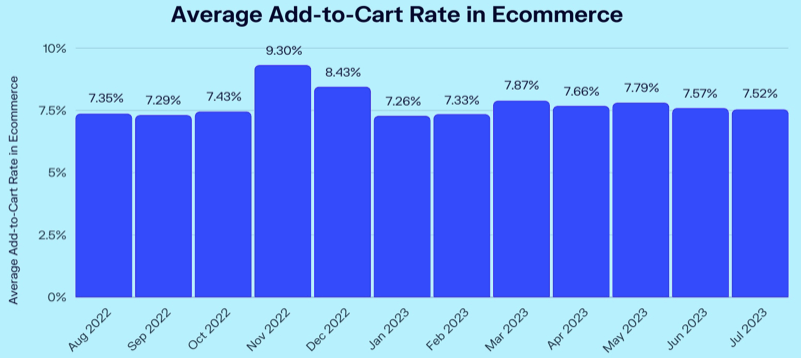
Did you know that eCommerce dates back to 1994? It all started with the establishment of Amazon's online bookstore, which transformed into one of the most popular multi-product portals.
Nearly three decades later, it is estimated that 27.2% of the world’s population shops online. With the new users getting added daily, eCommerce is now an integral part of every retailer’s sales and marketing strategy.
One of the most important actions for merchants to drive their shoppers to take is adding items to cart. However, that action is one of the hardest things to achieve in today's well-saturated eCommerce universe. In this article, we will cover the strategies and tactics to increase the add to cart rate.
But let's start with the basics!
What is an add to cart rate?
While an eCommerce site may have many visitors, not all of them may be genuine buyers. Today, with the help of data analytics, companies are tracking website activity through various metrics such as bounce rate, revenue, acquisition cost, customer demographics, etc.
However, one critical metric that retailers should not ignore is the ‘add to cart conversion rate'. This metric is used to identify qualified buyers by tracking how often people add at least one product to their cart.
Here’s an add to cart rate formula: This rate is arrived at by determining the total number of sessions where a user adds an item to the cart, dividing it by the total number of sessions, and multiplying the result by 100. The session considered in the numerator is typically those sessions where visitors have placed at least one item in their cart.
The add to cart conversion rate metric is essential as it measures the success of the products retailers have displayed, their marketing efforts, and their E-commerce website functionality.
The Databox survey mentions that the average add to cart rate range is around 3-4%. If a retailer's website has a total of 30,000 sessions and 750 identified add-to-cart sessions in a quarter, then the add to cart rate for that period is 2.5%. Hence, considering the industry average, the retailer can deduce that it is a reasonable add to cart rate. However, improving these rates could mean a significant increase in revenue for the retailer’s business.
It is estimated that around 30-40% of users who add an item to their cart eventually made a purchase. Hence, analyzing the add to cart (aka 'Add To Basket') is an essential part of running an eCommerce store.
What is add to cart rate formula?
Just like for measuring other KPIs of your E-Commerce business, there is an add to cart rate formula, too. To calculate your online store’s add to cart rate, first select a time period. Then divide the total number of times shoppers placed a product to their cart by the total number of site sessions during that time period. Divide that figure by 100 to get a percentage, and you've got your average add to cart rate.
What is the average add to cart rate?
Studies show globally, the average monthly add to cart rate in 2023 is 7.83%. This means, less than eight shoppers out of hundred add items to their shopping cart. Now, this rate can be measured for many other factors, such as, average add to cart rate in specific regions, by devices ordered from, countries, continents, etc.
Here’s a graph that shows the average add-to-cart rate in eCommerce over the last one year:

‘Add to cart’ or ‘buy now’: The difference and which one is better?
Even though ‘add to cart’ and ‘buy now’ may seem to be the same and look the same, they are different. More importantly, they work differently in improving your average order value.
When customers click on ‘add to cart’, the product gets added to their shopping cart and customers remain on the same page; continue shopping. But when one clicks on ‘buy now’, the button automatically takes customers to the checkout page. Hence, customers’ browsing activity stops when they click on buy now.
Moreover, with the add to cart button, customers don’t feel the pressure of actually buying the product right there and then. In fact, they can keep adding many products to their cart and then purchase them at a later time and date.
This gives customers freedom, flexibility, and ease of shopping. The add to cart button also helps increase the add to cart conversion rate of your site. Thus, ‘add to cart’ is a better option to add to your eCommerce website and app.
Here’s a recap of the benefits of ‘add to cart’ over ‘buy now’:
- Customers can continue browsing more products
- It helps increase the add to cart rate of sites
- Customers don’t feel the pressure to make instant purchases
- Customers can make informed and thought-through purchases
- It increases the possibility of sales as it psychologically relaxes customers

10 ways to increase your add to cart rate
On average, only 1.94% of E-Commerce website visits convert into a purchase. Hence, if a retailer's add to cart rate is low, it is essential to understand how to increase it and drive more sales for your business. Even if your rate is high, there's always room for improvement.
Let's look at some optimization techniques to improve your add to cart rate on an E-Commerce platform :
1. Build an app for your online store
More than 43% of total retail E-Commerce sales is said to be via mobile in 2023.
The rising use of mobile devices for shopping emphasizes the importance for retailers and online marketplaces to develop well-designed, user-friendly experiences. Apart from E-Commerce websites, another imperative is having mobile applications.
E-Commerce mobile apps help improve conversion, increase brand awareness, better customer loyalty, help retailers provide a personalized experience, enhance customer experience, improve marketing communication, make payments easier, and shopping faster, among other advantages.
When built well, your mobile app can help you improve the add-to-cart rate. Building efficient retail mobile apps is easy with Shopney. The no-code tool makes it easy to build and design mobile apps with comprehensive features that enhance customer experience and boost sales.
Also read: Reasons to Have A Mobile App With Shopney
2. Offer free or attractive shipping rates
Shipping costs create the impression of hidden costs and sometimes dissuade customers from buying products.
In fact, the likelihood of a consumer abandoning their purchase in the absence of free shipping is a whopping 61%. Hence, the 'free delivery' option turned into a standard practice that retailers must consider due to consumer behaviour.
Furthermore, 58% of consumers increase their purchases with the sole intention of qualifying for free shipping. Further, customers try various hacks such as delaying purchase decisions, opting for the slowest zero-cost delivery or making physical purchases.
With this customer behavioural pattern in mind, Amazon came out with a loyalty program (Prime) that provided free delivery and additional benefits, resulting in 78% of US-based customers signing up for Amazon Prime.
Offering free shipping, discounted shipping, same day shipping, and other such incentives are one of the best methods to increase the add to cart conversion rate for your web and app stores.
3. Optimization of Product Pages
Another way to increase the add to cart rate is to continuously optimize your product pages. 81% of consumers undertake research before placing an order online, making it one of the primary reasons consumers choose online shopping over in-store experiences.
While researching for products, prospective buyers visit websites and browse through apps before the final purchase. During this process, shoppers end up making informed decisions and even get encouraged to add products to their cart.
However, during the process, in case the browsing experience is not comfortable, or the user finds the content ambiguous, there is a high possibility that the user will not proceed with the purchase.
The co-founder of Y Combinator, Paul Graham, once said, "Overall, the web is pretty sloppy, but an online store can't afford to be." Hence, each retailer needs to concentrate on optimizing their content to connect with their audiences
Here are a few commonly used techniques in the E-commerce industry to increase add to cart rate.
- Embrace a visual pecking order by placing the main components at the topmost part of your page
- Large and clearly visible add to cart button that is easily clickable
- Incorporating colourful, high resolution & appealing images and placing them on a neutral background to help users visualize the products
- Less is more: Keep the design simple and the product descriptions crisp to provide a faster read for visitors
- Ensure enough white space within the layout coupled with conventional page navigation
- Pinning customer testimonials and detailed FAQs will nudge a visitor to add a product to the cart
4. Send Abandoned Cart Messages
One of the biggest gaps in the sales and marketing funnel in the E-Commerce industry is shoppers who abandon the cart, leaving the purchase unfulfilled. While the bad news is that over 69% of shopping carts are abandoned, the good news is that for deserted purchases, the follow-up emails have an average open rate of over 40%.
Hence, marketers can combat this phenomenon by implementing a robust email strategy and sending reminders to prospective customers after leaving the checkout page.
These emails entice customers with discounts & coupons and then further nudge them with a CTA button that takes them back to the cart for checkout. It always necessary to incorporate the following two elements in the emails :
- Urgency : Emails to include words like “last day”, “buy now”, “soon”, etc.
- Trust: Reiterate ratings and reviews of abandoned products
5. Add Customer Chat Boxes
One thing a virtual shopping experience lacks is physical interaction and query solving. Chat boxes step into the shoes of a virtual agent to respond to questions raised by customers on a real-time basis.
This method fills the gap for an automatic query resolution without having to spare additional resources by providing answers based on keywords or pre-built sequences. However, suppose a customer during his online browsing sessions cannot decide on a purchase due to lack of customer support. In that case, it may negatively impact a user's perception of your website.
In fact, 62% of customers who have had an unsatisfactory experience are less likely to associate with that brand in the future. If a customer has to wait for an email from the support team, it is possible he also already looked at alternative products in the meanwhile.
Marketers can quickly rectify this issue with a pop-up chat window that subconsciously encourages customers to interact with the company providing immediate answers. Adding a live chat box thus increases the add to cart rate—customers can get their questions answered, doubts cleared, and safely add products to their shopping carts.

6. Use an Exit-Intent Pop-Up
While pop-ups tend to be intrusive, however, they are adept at making a customer stay on the website a bit longer from a retailer's perspective. With the help of predictive analytics and machine learning, a company in the back-end can track user movement on screen and trigger messages based on customer behavior.
The algorithm based on mouse movements knows when to provide product recommendations on discounts based on the tracked customer requirements. This technology driven E-commerce solution helps plug in issues that cause abandoned carts or lost sales, etc.
7. Upsell and Cross-sell
The role of a store assistant can now be designed as a feature in your e-commerce website or app. On the floor, an assistant has two primary sales roles; one is to cross-sell (recommend a supplementary product), and the other is to upsell (inducing a customer to make a purchase with a higher value than their shortlisted one). However, how is this translated on a virtual platform?
Suppose a customer wants to purchase an anti-ageing cream, the virtual assistant would probably suggest an anti-ageing serum as a part of its cross-selling strategy. Alternatively, if a pop-up recommends another premium anti-ageing product with additional benefits, it would be a form of upselling.
Such product recommendations account for an average of 10-30% of E-Commerce businesses’ revenues. The online selling giant Amazon has mastered product recommendations using collaborative filtering and is estimated to generate around 35% of its revenue solely from cross-selling.
This method of selling results in increasing Average Order Value (AOV), consequently increasing add to cart rate. However, the recommendation must remain realistic for fear of resulting in higher abandoned carts and lower conversion rates.
8. Design the ‘add to cart’ button well
Shoppers see many different elements on product pages — images, description, video, cross-sells, banners, marketing content, etc. In between all this, the ‘add to cart’ button can easily get lost if not designed well. This could also be a factor keeping shoppers from clicking on the ‘add to cart’ button.
But if designed to influence customers psychologically and lead them to take action, you can increase the add to cart conversion rate of your E-Commerce business.
Here’s how you can increase the add to cart rate via best design practices for mobile:
- Style the add to cart button in a way that differentiates it as a major button on the page
- Direct shoppers’ attention to the button via visual distinction
- Consider using contrasting colors or button shapes
- Differentiate CTA buttons of other elements such as cross-sells
- Ensure the add to cart button is large enough and sticky
Using a good app builder can help you customize your add to cart button. If you’re exploring mobile app tools for your eCommerce business, explore Shopney.
9. Use FOMO marketing tactics
Another way to increase add to cart rate is FOMO (Fear Of Missing Out). It can lead shoppers to make impulse purchases. In fact, 60% of consumers say they have experienced FOMO.
It is an efficient technique to get shoppers to add products to their carts. FOMO helps create a sense of scarcity and urgency and entices shoppers to grab an opportunity before it’s gone.
Here are some ways to use FOMO to drive customers to add products to the cart:
- Include a countdown timer on the product pages
- Show remaining pieces count
- Offer limited period discount or deal
10. Provide multiple payment options
When you run an eCommerce business, you might have customers who have different preferences for payment options. For example, if yours is an international ecommerce brand serving customers in different countries, you will definitely need to offer multiple payment options.
One of the main reasons for cart abandonment is a lack of payment options. Moreover, shoppers are more likely to avoid browsing and adding products to the cart if they know you do not offer specific payment options.
As a result, adding more payment methods is an excellent approach to increase your add to cart rates. Aside from credit card payments, you can also use PayPal, bank transfers, wallets, and even buy now, pay later.
Most people now prefer to use mobile payment options. Integrating these options in your mobile app is easy and makes payments easier, thus improving your add to cart conversion rate.
11. Add social proof
95% of customers read reviews before buying any product online. Therefore, customer reviews and social proof should be an important aspect of your ecommerce platforms — website and mobile app.
Once shoppers are reassured about the products they are going to purchase, it becomes easier for them to add products to the cart.
So, what kind of social proof can you mention to increase your add to cart rate.
- Show customer reviews of products
- Real-time sales statistics and numbers
- Ways in which customers use the products
- Feedback ratings and stars
12. Include elements that build trust
Even though online purchases are increasing, customers can find it difficult to trust brands. And that is why eCommerce brands have to put in a lot of effort to build customer trust. How do brands do that? By including different elements that help give assurance to customers.
Let’s look at some trust-building elements you could include in your eCommerce website and app to increase the add to cart conversion rate.
- Show your brand success, for example, awards, recognition, etc.
- Show reviews and testimonials
- Product details and how-to guides
- Security seals and certifications
- The age of your business
- The number of orders shipped
- The regions and places orders shipped
Mobile Commerce - The Way Forward
The add to cart conversion rate is increasingly playing a huge role in the purchasing process. The online culture dominates the current business landscape, with customers expecting to receive products 'on-demand’.
Hence, the competition is fierce, and retailers have to implement innovative tactics to grow in the eCommerce space. By understanding your company's add to cart conversion, companies can implement strategies that will boost their revenues exponentially.
The Shopify Store is a platform that integrates measurement and optimization of customer experience to improve conversions and add to cart rates. Download the Shopney mobile app and reach out to us to design and personalize your platform today!



